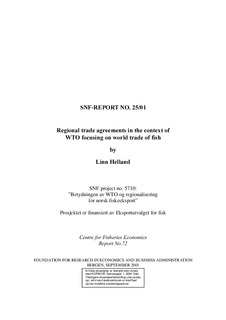| dc.contributor.author | Helland, Linn | |
| dc.date.accessioned | 2006-07-05T11:34:29Z | |
| dc.date.available | 2006-07-05T11:34:29Z | |
| dc.date.issued | 2001-09 | |
| dc.identifier.isbn | 82-491-0146-4 (trykt versjon) | |
| dc.identifier.issn | 0803-4036 | |
| dc.identifier.uri | http://hdl.handle.net/11250/164639 | |
| dc.description.abstract | The main objectives of this report are to give an overview of the existing regional trade agreements and to analyse their impact on trade of fish within a region, between regions, between a region and important trading partners. Fish and fishery products are among the most traded foodstuffs internationally. The level of trade has been growing at an accelerating pace in the last decade, reflecting increased production, particularly in aquaculture, and increased demand. There has been a continual process where decision making on market access has been transferred from a national to a supranational and global level. The main international agreement regulating the flow of goods across borders is the General Agreement on Tariffs and Trade. The WTO regulations permit explicitly that regional groupings of countries enter into free trade agreements or custom unions to reduce the trade barriers between each other. Since the establishment of GATT in 1947, more than 100 regional trade agreements have been created. | en |
| dc.format.extent | 997258 bytes | |
| dc.format.mimetype | application/pdf | |
| dc.language.iso | eng | en |
| dc.publisher | SNF/Centre for Fisheries Economics | en |
| dc.relation.ispartofseries | Report | en |
| dc.relation.ispartofseries | 2001:25 | en |
| dc.relation.ispartofseries | Report | en |
| dc.relation.ispartofseries | 72 | en |
| dc.title | Regional trade agreements in the context of WTO focusing on world trade of fish | en |
| dc.type | Research report | en |
